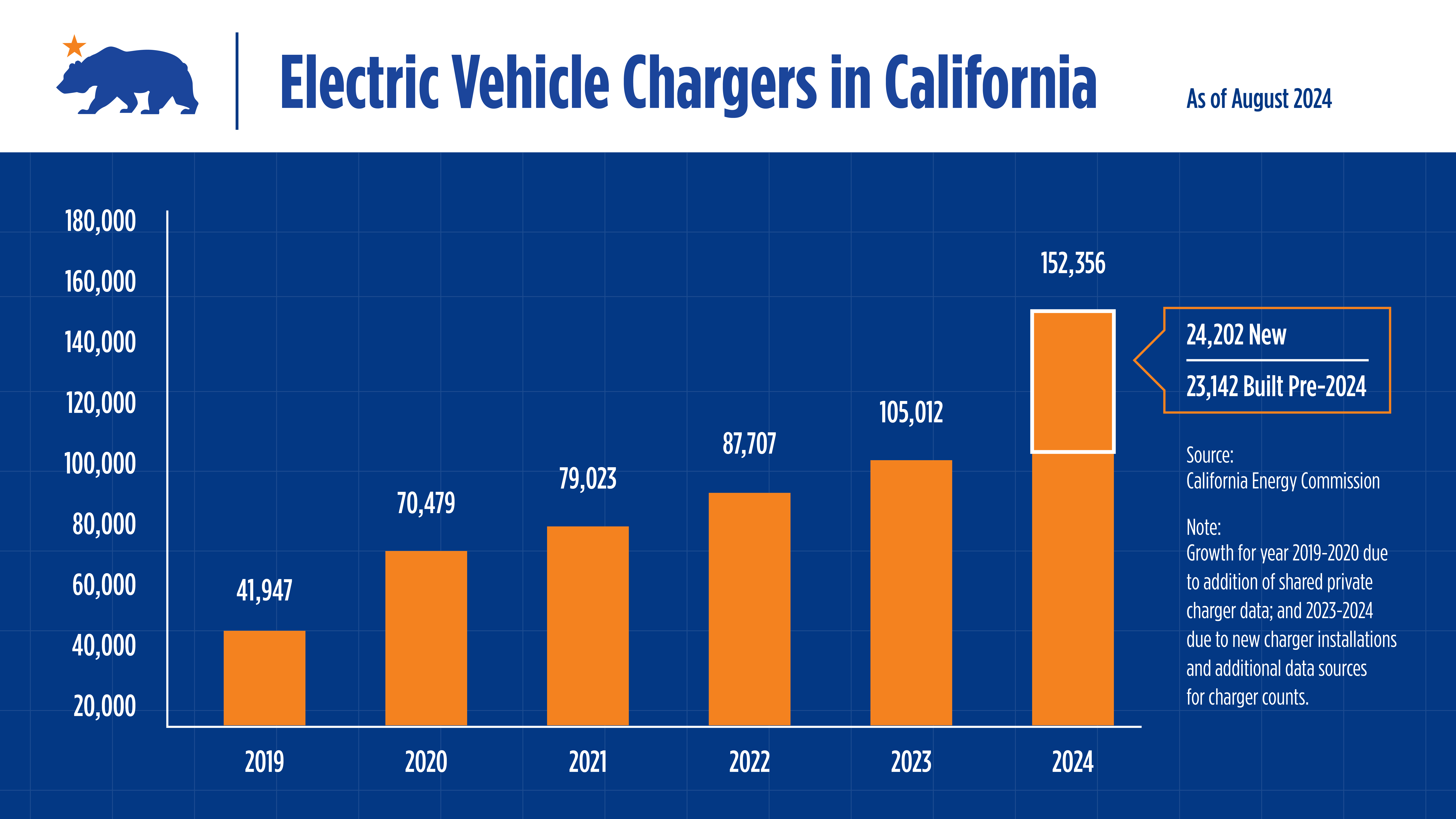For Immediate Release: August 28, 2024
WHAT YOU NEED TO KNOW:
California continues to rapidly expand the most extensive electric vehicle (EV) charging network in the country, installing 24,202 chargers in the first half of 2024.
SACRAMENTO — Today, Governor Gavin Newsom announced California has surpassed 150,000 public and shared private chargers installed statewide, including 137,648 Level 2 chargers and 14,708 fast chargers. This announcement comes just weeks after California posted its second highest ever market share in zero-emission vehicle (ZEV) sales.
“When it comes to zero-emission vehicle infrastructure, California has no peers,” said Governor Gavin Newsom. “The state is all-in on clean transportation, dedicating unprecedented investments to supercharge our transition. We’re building a bigger, better charging network – faster.”
In addition to the public network, the state estimates that more than 500,000 private home chargers are installed statewide.
RAPIDLY DEPLOYING FUNDS
No other state comes close to California's ZEV infrastructure efforts, dedicating billions to support clean transportation goals. The state is also expected to receive more than $380 million from President Biden’s Infrastructure Investment and Jobs Act for building out chargers.
This year, the California Energy Commission has approved more than $1 billion in funding for EV charging and hydrogen refueling projects for cars, trucks, and buses. The projects range from deploying chargers in underserved communities to rapid expansion along the state's busiest corridors. Highlights include:
- $3 million to install at least 40 fast chargers across 10 sites in Southern California to meet demands from transportation network company fleets and the public.
- $5 million to install Level 2 and fast chargers, bus charging ports, solar photovoltaic equipment and battery storage at a destination multi-use park and future Olympic venue in Los Angeles.
- $7 million to build at least 653 Level 2 chargers near the University of California San Diego.
- $9.5 million to improve and maintain hydrogen refueling stations statewide.
- $12 million for EV charging at apartments and townhouse complexes.
- $24 million to support medium- and heavy-duty (MDHD) zero-emission vehicle charging or hydrogen refueling infrastructure along important state highway and interstate corridors.
- $30 million to increase in-state manufacturing of ZEVs and related equipment.
- $33 million to accelerate the successful commercial deployment of MDHD charging at ports and business centers.
- $268 million for MDHD electric charging and hydrogen refueling infrastructure incentives.
- $390 million for electric school bus charging.
BETTER DATA COLLECTION
California is working hard to improve the EV driver experience in the Golden State. Part of that effort includes gathering better data to understand where chargers are most needed and to track the state’s progress in meeting its EV charger goals.
Today's announcement of updated charger totals is the result of improved data collection by the CEC through the use of additional data sources to track operational chargers. Of the 48,000 chargers added to the data set since the end of last year, 24,202 new chargers were installed in the first half of 2024. The remaining 23,142 chargers were installed before 2024 and identified through new data sources.
Each day, more EV chargers are coming online in the state, improving the day-to-day life for California’s EV drivers.
IMPROVING THE EV DRIVER EXPERIENCE
While building new chargers is paramount for meeting California’s clean energy goals, the state is equally focused on improving charger reliability through:
- Charger uptime and reliability reporting requirements for publicly funded EV charging projects.
- Forthcoming first-in-the-world state EV charging reliability regulations that will track the reliability of publicly funded EV chargers and set minimum reliability standards.
- A real-world field-testing program cataloging the reliability of EV chargers conducted by UC Davis.
Increasing the adoption of EVs requires a charging network that is reliable, accessible, and convenient. The state is committed to creating a seamless charging network by making it easier to find chargers, simplifying payment processes, working with EV service providers to improve communication between the vehicle and charger, and requiring chargers to install Plug and Charge capability, which will allow drivers to simply plug in and pay without swiping a payment card.
State agencies are working tirelessly to accelerate deployment, cut through red tape, and strengthen the grid to make California the world’s best place for EV drivers.
CALIFORNIA’S ZEV RECORD
California’s ZEV record speaks for itself. Since Governor Newsom’s executive order in 2020 calling for a rule to require all new car sales to be zero-emission by 2035, ZEV sales have risen dramatically.
- 25.7% of all new cars sold in California in Q2 of 2024 were ZEVs, according to the California Energy Commission
- 118,181 ZEV sales in Q2 of 2024, an average of 1,300 sold each day
- 1,996,931 total ZEV sales to date
- 34% of new ZEVs sold in the U.S. are sold in California, according to the California Air Resources Board
- 60 ZEV and ZEV-related manufacturers are operating in California — leading the nation in ZEV manufacturing jobs.
- Thousands of dollars in grants and rebates available for low-income Californians. Learn more at ClimateAction.ca.gov or ElectricForAll.org
###
About the California Energy Commission
The California Energy Commission is the state's primary energy policy and planning agency. It has seven core responsibilities: advancing state energy policy, encouraging energy efficiency, certifying thermal power plants, investing in energy innovation, developing renewable energy, transforming transportation, and preparing for energy emergencies.
Newsroom
Media Contact
Media and Public Communications Office
MediaOffice@energy.ca.gov
(916) 654-4989

